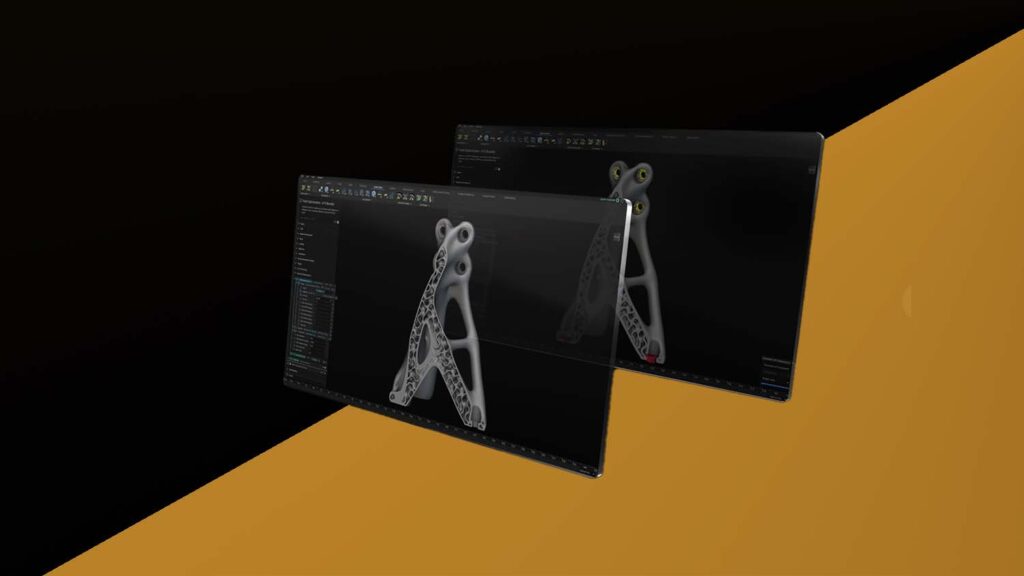nTop 4 has launched with the top line aim of enabling engineers to bring additive manufacturing to mainstream production for complex, high-performance parts by reducing the number of impractical and time consuming manual iterations needed when creating a part.
A big part of this lies with its headline new feature, Field Optimization, which it calls a new generative design technology to help engineers navigate the overwhelming number of design parameters introduced by complex engineering problems, accelerating decision-making and improving part performance.
Field Optimization layers a multi-scale and multi-objective optimisation engine on top of nTop’s core technology, resulting in a design tool that it says is both extremely powerful and easy to implement.

The new approach relies on a novel combination implicit modelling technology, Field-Driven Design approach, and a generalisation of nTops’s existing topology optimisation framework. The new capability allows engineers to focus on specifying the design intent and requirements of the part while letting the software automatically determine the complex geometric details such as lattice layouts, wall thicknesses, rib patterns, and/or other spatially-varying parameters.
nTop says that its Field Optimization technology is similar to that of traditional topology optimisation, while the most noticeable difference is that the underlying material model used to compute the properties of the structure is now a function of any number of geometric design parameters, rather than just a single value, such as material density.
For example, to optimise a satellite bracket for the NASA Excite challenge, the nTop team started by using a traditional topology optimisation to get the global shape and then subsequently applied a ‘shell and infill’ optimisation to further reduce the weight and increase the stiffness of the part. nTop says that this resulted in a part twice as durable under vibration loading conditions (the driving requirement for this part) while still coming in 6 per cent lighter than alternative approaches used to date.
“At nTop, we have always believed that design is at the core of solving the world’s hardest engineering problems. nTop 4 marks the next stage of our journey enabling engineers to deliver highly engineered AM parts for products to reach new levels of performance,” says nTop CEO Bradley Rothenberg.
// Files for miles
Elsewhere the new release hasn’t held back on new features and plug-ins, with much of this based around Implicit Interop, which helps bring models from the screen into physical parts.With nTop 4 Implicit Interop looks to ensure users have a reliable and feasible path to production, even for the most complex designs, making it possible to directly exchange nTop geometry in a compact file format (a new *.implicit extension) that can be read and queried by other tools using a lightweight library which nTop is making available to partners.
Implicit Interop manages to exchange complex design data in the kilobytes to megabytes range, not gigabytes, and is being introduced in two product forms: nTop Plugin for EOSPRINT, and nTop Core.
The nTop Plugin for EOSPRINT allows users of EOS 3D printers to directly import, setup, and print nTop designs on EOS printers natively, going live in EOSPRINT 2.14, scheduled for release in June 2023.
“With this new capability we’ve seen complex designs that used to take days to mesh and slice load in EOSPRINT in minutes, allowing slicing to be done on-demand during the manufacturing process to achieve the optimal accuracy of the AM system,” says an nTop spokesperson.
Meanwhile, nTop Core acts as a simple, lightweight library for partners to integrate nTop native geometry in their own tools and systems, enabling users to seamlessly integrate nTop into their own product development process.
This library is already powering the nTop Plugin for EOSPRINT. To test this further nTop explain how it collaborated with Inkbit which was able to independently incorporate the library into their software to read, query, and ultimately manufacture nTop parts directly from the *.implicit file itself without any meshing.
In order to deploy nTop at scale, the company is also launching nTop Automate, allowing nTop workflows to be programmatically executed for use cases such as design space exploration, batch processing, and mass customisation.
With support for both Windows and Linux, customers can now deploy nTop workflows on more powerful computing hardware and/or cloud environments using more cost effective infrastructure.
Ocado Technology – featured onstage at D3D LIVE 2022 – is a great example of this, its automated part design and evaluation process allowing them to compress their prototyping cycle from months to a three week design sprint for the development of their new 600 Series Bot.
On the face of this release, nTop 4 is more than just a rebrand and a glow-up – there’s some key updates here that look set to add further function and approachability to the company’s already stellar offering. With further AM companies likely to be lining up behind EOS to implement plug-ins, expect more user benefits to follow for those serious about their additive manufacturing as an end-use means of production.






